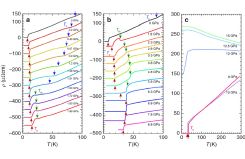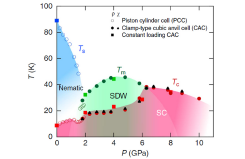Mechanism of High-Temperature Superconductivity in FeSe Unveiled via the Magneto-Transport Measurements under High Pressures
Uwatoko and Yamashita Groups
Recently, the layered β-FeSe has aroused tremendous research interest due to the observations of many intriguing physical properties. At ambient pressure, FeSe develops an electronic nematicity below Ts = 90 K, which, however, is not accompanied by any long-range magnetic order. The absence of static magnetism in FeSe is in strikingly contrast with the majority of parent compounds of FeAs-based superconductors. Interestingly, it was found that a static magnetic order emerges at pressures above 1 GPa and the transition temperature Tm increase concomitantly with the superconducting transition temperature Tc up to 2.5 GPa. The relatively low Tc ≈ 9 K of FeSe at ambient pressure can be enhanced significantly to Tcmax ~ 40 K at about 7 GPa, however, the evolution of Tm(P) and its relationship with Tc remains largely unknown for P > 2.5 GPa due to the constrains of high-pressure techniques.

Fig. 1. Temperature dependence of resistivity ρ(T) in FeSe single crystals under high pressure. (a) ρ(T) curves below 100 K at different pressures up to 1.9 GPa measured in the PCC. (b) ρ(T) up to 8.8 GPa measured with the CAC. (c) ρ(T) up to 15 GPa measured with a smaller CAC. Except for (c) the ρ(T) curves are vertically shifted for clarity. The resistive anomalies at transition temperatures Ts, Tm, and Tc are indicated by the arrows.

Fig. 2. T-P phase diagram of bulk FeSe. The structural (Ts, blue), magnetic (Tm, green), and superconducting transition temperatures (Tc, red and black) as a function of hydrostatic pressure in high-quality single crystals are determined by anomalies in resistivity ρ(T) and ac magnetic susceptibility χ(T) measured in the PCC and CAC.
Thus, a comprehensive T-P phase diagram of FeSe is highly desirable in order to achieve a better understanding on the interplay of high-Tc superconductivity with magnetism and/or nematicity, which is commonly believed as an essential issue for the iron-based superconductors. For this purpose, we have carried out a detailed magneto-transport study on the FeSe single crystals up to 15 GPa by using the piston-cylinder cell (PCC) and the cubic-anvil-cell (CAC) apparatus; the latter has the merits of good hydrostaticity and large pressure capability.
Figure 1(a) displays the temperature dependence of resistivity ρ(T) for FeSe single crystal under pressures up to 1.9 GPa measured with PCC. We can see clearly that the nematic order at Ts manifested as an upturn in ρ(T) is suppressed gradually by pressure and smears out above 1.5 GPa. Nearly at the same pressure, another upturn anomaly appears at Tm = 20 K corresponding to the emergence of static magnetic order, and Tm increases gradually with pressure. In this pressure range, Tc defined as the zero-resistivity temperature first increases, and then decreases slightly before raising again. ρ(T) data shown in Fig. 1(b) measured with CAC can further track the evolutions of Tc and Tm. As can be seen, Tm increases gradually with pressure, but the upturn anomaly becomes weaker, and changes to a downward anomaly at 2.8 GPa. Tm reaches the maximum of 45 K at ~5 GPa, above which Tm disappears quickly and merges with Tc. Within the pressure range where Tm increases, Tc keeps nearly unchanged at ~20K, and then the suppression of Tm is accompanied with a sudden enhancement of Tc. The maximum Tc of 38.3 K is achieved at 6.3 GPa where the magnetic order just collapses. Above 6.3 GPa, Tc decreases slowly with pressure until ~ 12 GPa, above which FeSe adopts a three-dimensional NiAs-type structure and becomes semiconducting.
We have further performed measurements of ρ(T) under various magnetic fields for each pressure. The insensitivity of Tm to external magnetic field rules out the possible cause of resistivity drop at Tm due to the onset of superconductivity. In addition, we also measured the ac magnetic susceptibility χ(T) up to 8.8 GPa to determine Tc and obtained nearly consistent results with resistivity.
Based on these above results, we constructed the most comprehensive T-P phase diagram of FeSe as shown in Fig. 2, from which we can see explicitly how the three competing orders evolve under pressure. The application of high-pressure destabilizes the nematic order and then induces the long-range magnetic order, confirming the competing nature of these two electronic orders. When Ts is completely suppressed around 2 GPa, Tc experiences the first step increase to ~20 K. But Tc keeps nearly constant when Tm increases with pressure, which demonstrates the competing nature of magnetic order with superconductivity. The magnetic order is finally destabilized upon further increasing pressure to around 6 GPa when Tc undergoes a sudden jump to ~40 K.
For the first time, we uncover the dome shape of magnetic phase superseding the nematic order, and demonstrate that the high-Tc superconductivity in FeSe is achieved by suppressing the long-range magnetic order. This is quite similar with the situations seen in the FeAs-based superconductors. To achieve a better understanding on the importance of magnetic fluctuations, further studies on the electronic structure of FeSe under high pressures are needed. It is also interesting to note that the obtained phase diagram highlights unique features of FeSe among the iron-based superconductors, but bears some resemblance to that of high-Tc cuprates.
References
- [1] Sun J. P. et al., Nat. Commun. 7, 12146 (2016).
